
|
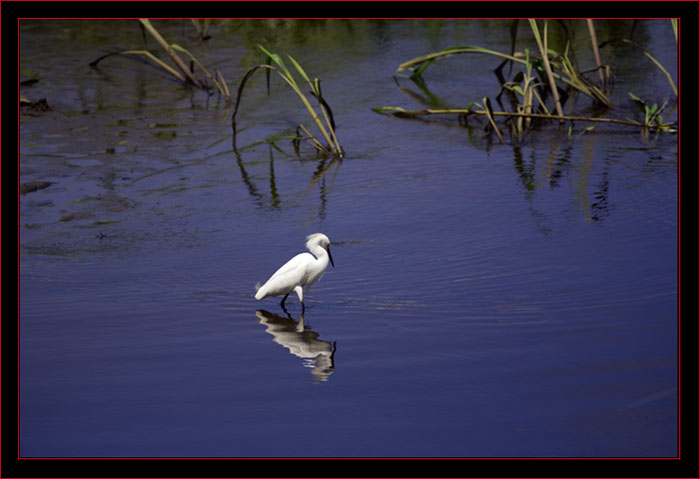
|
June 25thThe Savannah National Wildlife Refuge (SNWR) includes areas on both sides of the Savannah River so occurs in both Georgia and South Carolina. It was established in 1927 and includes just over 14,000 acres in GA and 15,000 in SC. I’d been on the four-mile long Laurel Hill Wildlife Drive, located six miles south of Hardeeville in South Carolina on several occasions and wished to go back. This area is about a fifteen/twenty minute drive north from Historic Savannah. Although I’ve never spend any time of significance in Hardeeville, it’s kind of dear to my heart as my great, great, great grandfather, James Peeples Youmans, joined the Confederate States Army there in March of 1862. We crossed the bridge in Savannah and traveled north on Route 17 into South Carolina. Before leaving the car rental place I’d asked one of the staff about getting to the refuge to refresh my memory. Indications were it was just over a mile once you crossed the river. In the end result it was considerably much more than a mile, perhaps ten or so, but as we were informed, it’s well marked and after getting over the fact we may have missed it, finally came upon some signs and turned into the refuge road. It was as I remembered it – a fairly quick car tour for those with little time or inclination to get out into the swampy environment. I have no doubt that many varied creatures and plants of many types can be found in this area if one had time to get out on foot. We were like the rest of the tourists checking this area out although there weren’t many on the road with us at this time. The road meanders through an area of earthen dikes with freshwater impoundments which in times gone by were the rice fields of plantations dating back to the mid/late 1700s. |
|
We stopped at the first small bridge and talked with a lady and two children looking over the side at an American Alligator. This gator appeared to be about six to eight feet long although only the head was visible. Also in view were several other gators swimming around so
I took some photographs of them as well. We chatted for a bit and is generally the case, they asked about the lens on my camera – it’s not that large really at just over ten inches in length, but it is appreciably larger when mounted on the 5d body compared to a ‘point and shoot’ styled zoom. I had them pose for a photograph
& provided my website card so they could contact me later so I could send the image along. If they don’t contact me perhaps they’ll see their photo is this account at some point because now they're famous!
This wetland site looked much like others I had visited since the advent of summer and many of the usual birds could be seen flitting about. We didn’t have to go far to see some activity. Some Boat-tailed Grackles were nearby, a Great Egret was poised fairly close to our location viewing the water where fish could be seen jumping and could actually be spotted swimming near the surface in the shallows. I took a few shots to get a meter reading on the camera, the sun was still quite harsh and I adjusted the settings to get the histogram where it should be for the lighting. It doesn’t take much to overexpose a bright white egret and I used the one in sight as a photographic aid. From experience I knew that once we advanced towards this bird it wouldn’t be there long. It appeared to me these birds weren’t quite as comfortable with a human presence as their Florida counterparts. They didn’t mind that we were around I don’t think, they just wouldn’t let anyone within their comfort zone. |
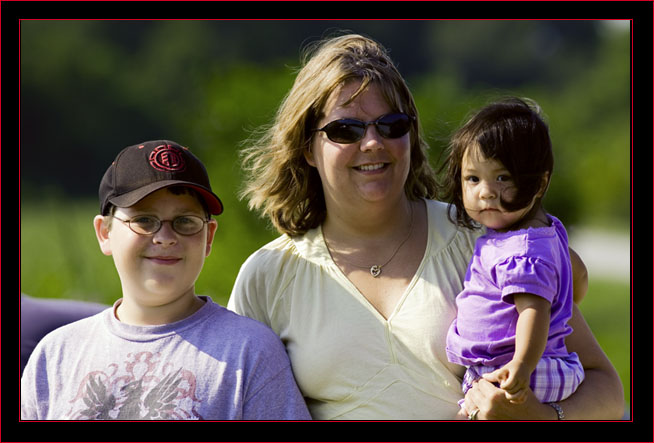
|
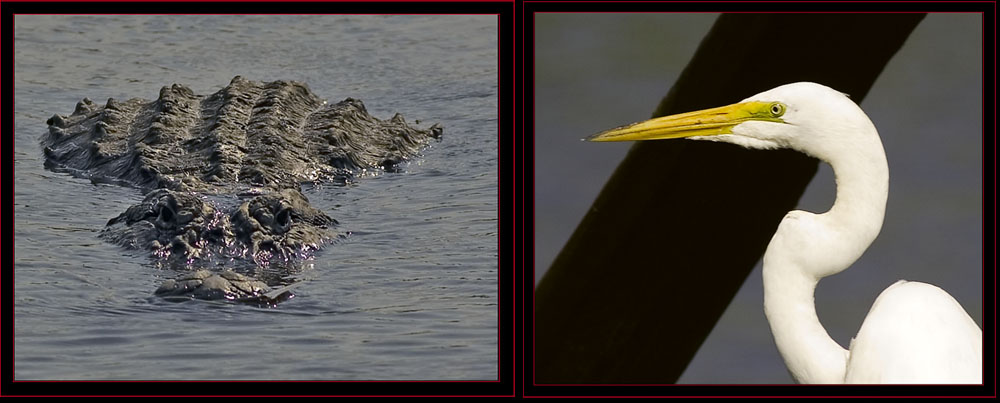
|
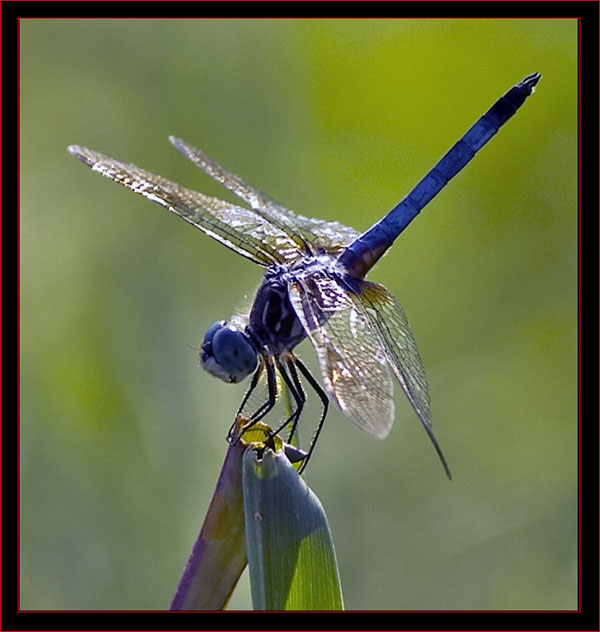
|
The wind was blowing enough to be problematic when imaging some of the plethora of dragonflies we viewed. These creatures love to perch up high on the grass and plantings near the water and they were swaying to and fro with the breeze. Rich thought this was
quite comical I believe as the minimum focus distance on the 400 f/5.6L lens in just less than twelve feet. Not exactly like trying to obtain a macro shot... I did get some exposures on some of the dragonflies though.
I'd get as close as I could trying to frame the subject with a background that wasn't too busy and then back up until focus could be achieved.
Looking down the road we could see a group of Common Terns using the wind to fish. A few were in the road as no cars were going by, others were flying into the wind while they foraged and every now and then they would land and more would fly off. These birds are quick and erratic in flight, at least while fishing. I decided to obtain some wing images and walked down to find a suitable spot. As is generally the case, as soon as I moved down so did the birds... We were the same distance apart so I figured this was as good as it was going to get. One positive aspect of the bright, harsh light was that it aided keeping the shutter speed quick for this type of imaging... |
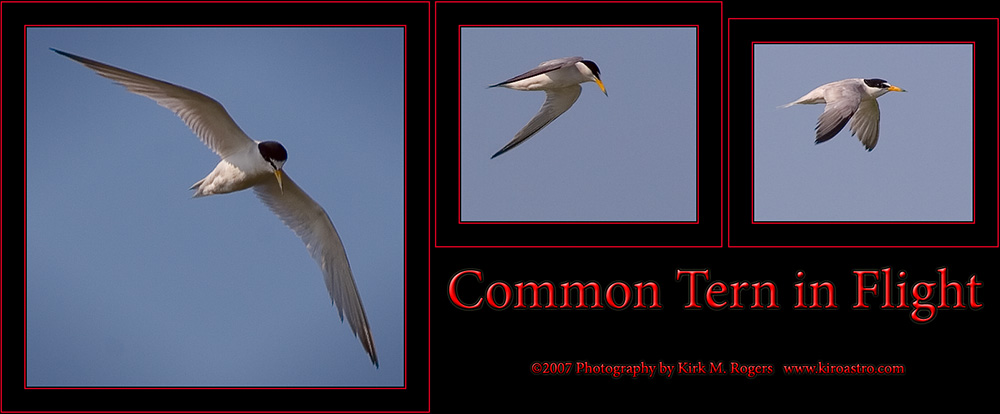
|
|
We’d spotted a bird flying in the distance which I was certain was an Osprey. After a time this bird meandered nearer to the road as we moseyed along. You can bet these two Mainers didn’t get too far from the air conditioned comfort of our rental car if we didn’t need to...
I got out and took a series of shots on the Osprey from quite a distance. The raptor was fishing and one of the series is the image displayed at right. While not a technically superior image, I like it because it portrays the action and focus these birds have while on the hunt.
And yes, this is the proper orientation as the bird went in for the capture – I didn’t rotate or alter the photograph framing.
|
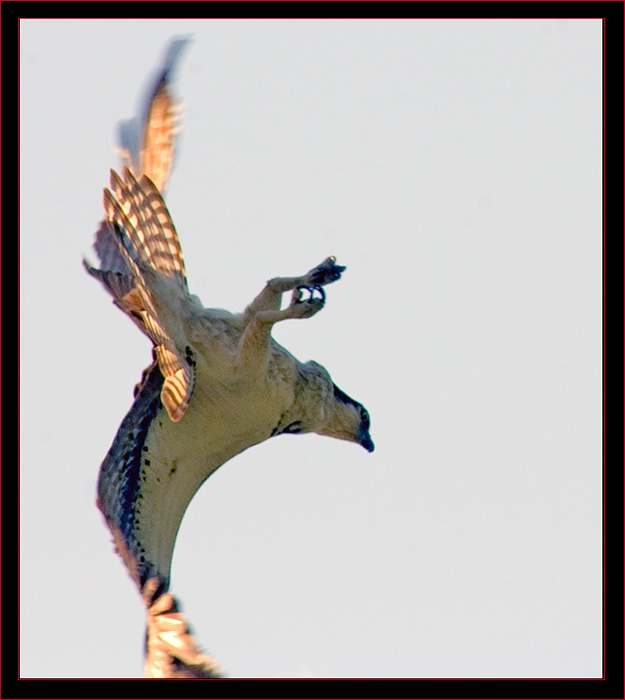
|
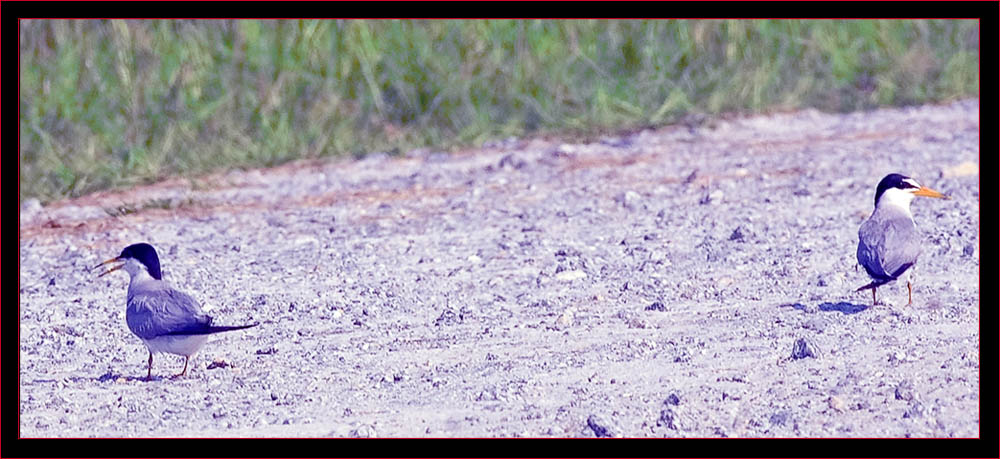
|
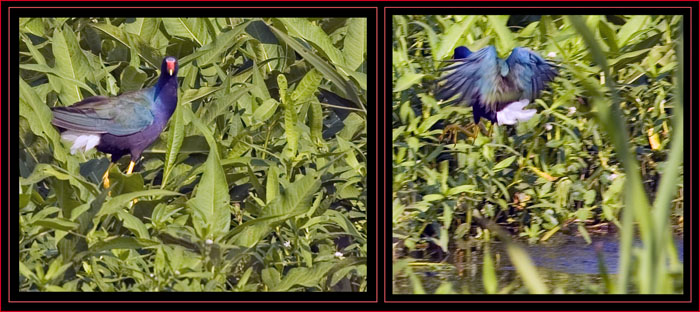
|
I heard an unfamiliar bird voicing at several areas as I walked along the road. I didn’t know what it was but it was close and I realized not far in the reeds and water growth these birds were lurking out of sight. Near this point I saw what they were – Purple Gallinules.
I knew about these birds, sometimes known as the Swamphen (actually a different but similar bird) but don’t recall in recent history having seen any. According to ‘The Sibley Field Guide to Birds of Eastern North America’ they can be found in Maine but only rarely.
At first I thought these were Common Moorhens, a species I’d imaged in Florida, until a good look revealed the pale blue frontal shield. Once you’ve viewed both in adult plumage you can easily tell them apart. So, I took some images although the birds I could
see were across the water & fairly distant for the focal length I was using. I figured I could find some others to get better images but this was the only ‘eyes on’ sighting of this bird in the days I visited – the balance of the time I knew they were around only audibly.
|
|
We’d viewed some Cattle Egrets alongside the highways as we drove around Savannah. I indicated to Rich I’d like to stop and get some photographs of these birds to add to my Bird Images Index.
I’d seen many examples of these in the south through the years but never up close or
with a camera available and this was a prime opportunity. It came as no surprise to see some of these in the SNRW. However, although some were near the travel path, they weren’t prone to be approached closely. This isn’t the best image of a Cattle
Egret I’d obtained by far at this facility being a bit overexposed, but it was taken the day this account is documenting so I’ll post it here. You can view other images of this bird later in the article that I would deem acceptable as print copies...
|
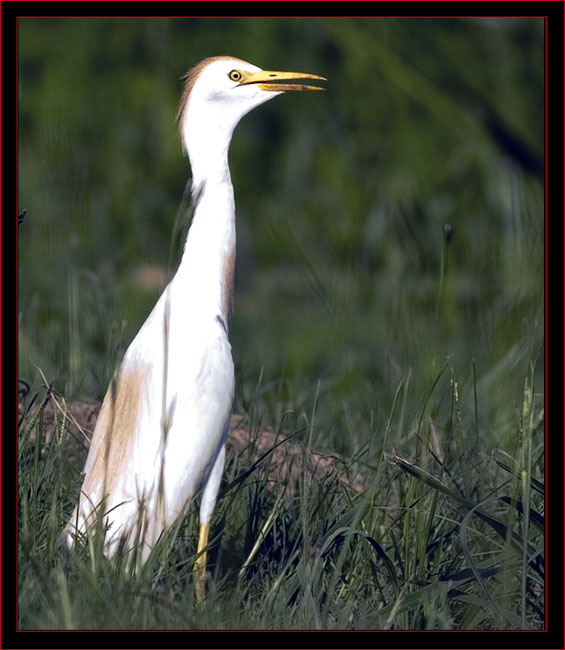
|
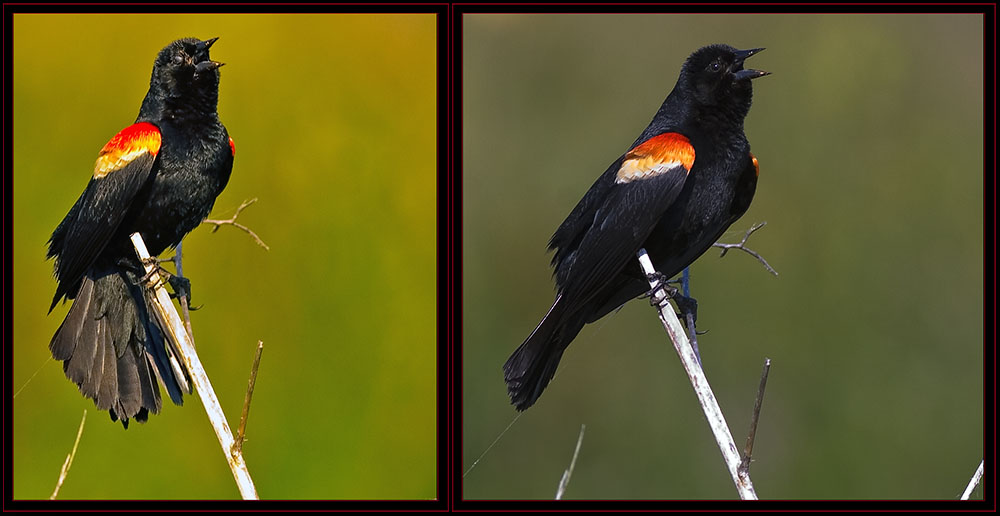
|
This environment is prime real estate for the plethora of Red-winged Blackbirds locally and there were many examples of this bird flying around the area. They like to perch near the water sometimes high up in the cattails and weeds on the bank. The best way to
obtain a reasonably close image of the examples we viewed was to stay in the car, using it as a blind. Rich was driving and I’d direct him to a degree to achieve the best background where possible. My favorite from this day can be seen at left. Of course,
this blackbird had his eyes closed as exhibited in the left-hand photograph so I'm glad I took more than one exposure – even birds have to blink at times, even at 1/500th of a second…
|
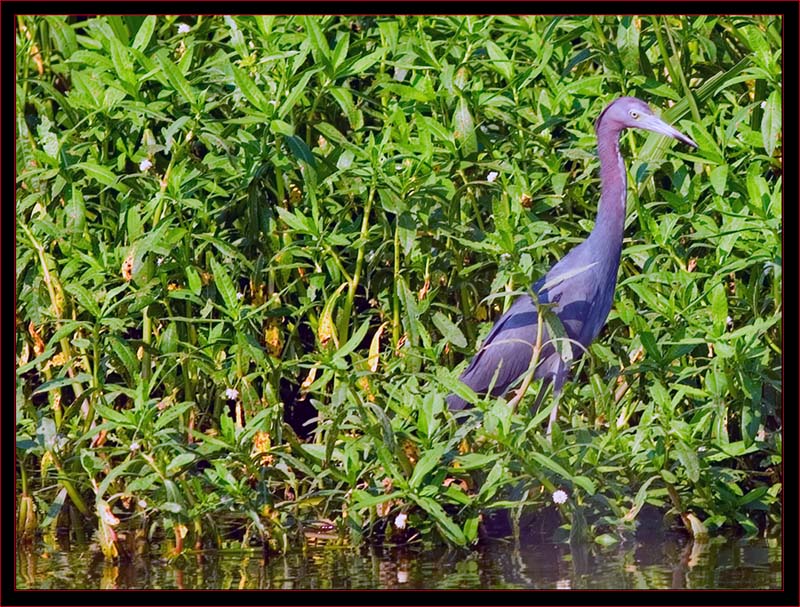
|
| While we were heading towards the wildlife refuge I’d spotted some ‘flamingo pink’ birds foraging in some water on my right. I have little wish to comment on Rich’s driving, but would state that I had an extremely short time to look at these birds – they were like a blur as we rocketed past (those of you reading this article that have traveled with Rich will know exactly what I mean when I said ‘rocketed’)… I was able to mark the area in memory and made a point to have him slow down as we neared the spot on the return trip… Rich turned around and pulled over on the shoulder so I could take a better look. What I found was a group of Roseate Spoonbills with an egret or two mixed in. There was a group not far from where I could walk in and some trees closer to the water to shield my approach… Even being as stealthy as possible, one of the birds spotted me and the group moved off towards the gaggle further in from the bank I approached. I was still close enough to image several from where I was & added some nice photographs to my 'index' from this stop. |
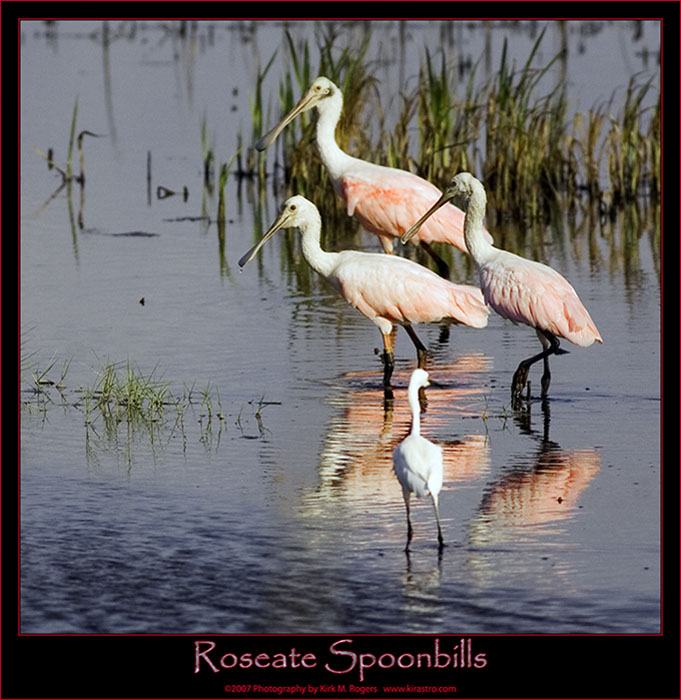
|
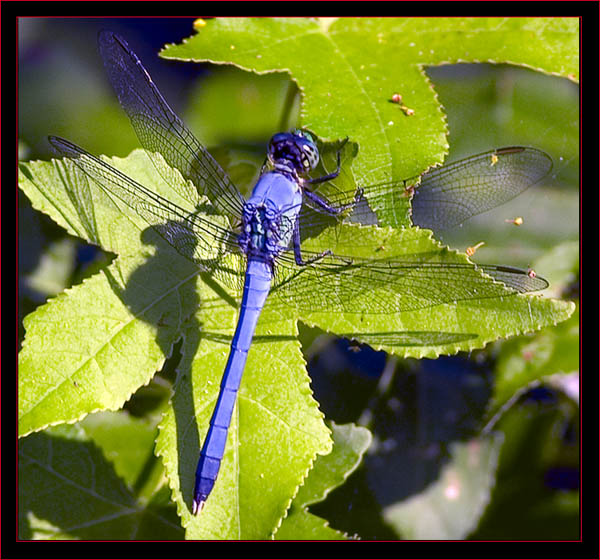
|
One of the many dragonfly specimens viewed in the area.
|
So we called it a day, capped off the lens and headed to our hotel for the evening. It would be an early night after an early start of the day - some dinner and off to bed... I can't speak for Rich but I was pleased we took the time to get out while we could.
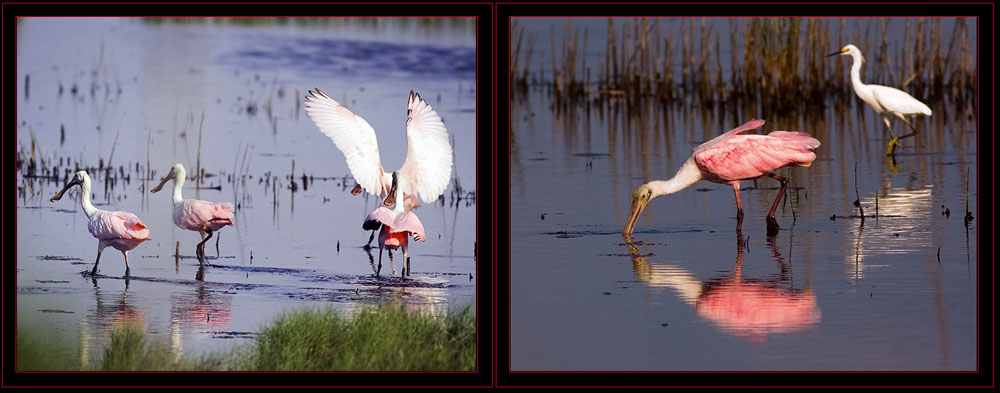
|
June 25th
| This is my image of Billy’s head in an osprey nest – I’ve always wanted to post this somewhere so I managed to work it into this account for his benefit. In case you’re wondering - Yes, this is a crudely done composite; Bill wasn’t really in the nest with the young osprey chicks – probably a good thing for all concerned... Billy’s company has worked with us in many areas of the United States since we conducted the initial Savannah rehab in 2002... |
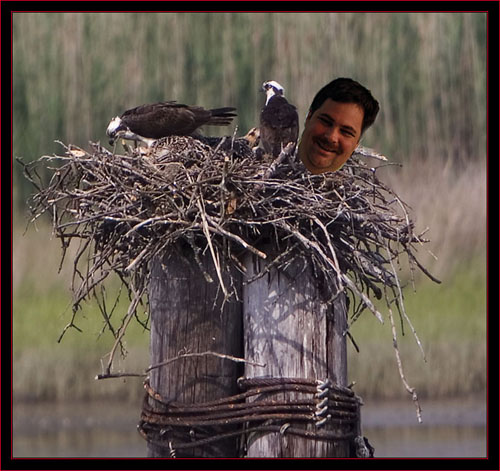
|
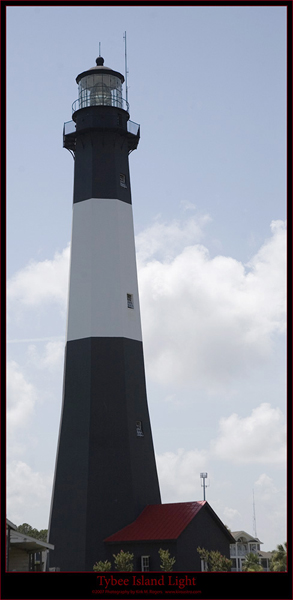
|
The Island is a short drive from Savannah so we weren’t long in making the journey. We stopped by the visitor’s center and I spoke with the attendant about what was around the area. They provided the usual
tourist map and we went off to drive around. We didn’t really stop anywhere, just traveled along the road bordering the water and looked around. Predicated on the buildings and businesses in the area,
one would not have known you weren’t in a typical resort town in Maine. We decided to visit the light station so followed the signs to this facility.
Like much of the eastern coast of the United States, Tybee Island has a varied history. Local accounts indicate the name may have come from the Native American word for salt, once of the many resources found in the area making it desirable for settlement. Starting with the early 1520’s Spain and a bit later France laid claim to the area. The island also has a history of pirate incursions, they would put in to take on fresh water and replenish supplies. In the early 1700’s James Oglethorpe arrived in the area with the intention of forming a colony he named Savannah. In 1736 General Oglethorpe caused the first lighthouse and a fortified position to be constructed as an aid to mariners and to control access to the mouth of the Savannah River. Savannah and the Tybee Island area played key roles in the Revolutionary through the American Civil Wars. In the Revolution, Savannah was lost to the British and Tybee served as a staging area for efforts to regain the city. However the combined efforts of the Continental and French forces failed and the British remained in control of the area until the end of the conflict. In the War of 1812 the Tybee Island Lighthouse served as a signal station to warn of impending attacks on Savannah, of which thankfully for the locals, none occurred. With the advent of war in 1861, Tybee Island was occupied by Confederate forces. Later that year by order of Robert E. Lee, who as an engineer pre-Civil War & developed defenses in much of the area, the Confederates were ordered into Fort Pulaski a short distance away. Fortifications like Pulaski, called ‘third systems forts’ were considered impregnable in this era. However, this would change rapidly with technological advances in artillery, especially rifled ordnance - the days of domination via stone fortresses were over. In early 1862, Quincy A. Gillmore, a Union Engineering Officer, was ordered to reduce the fort and he was quite successful with this task. Gillmore placed rifled canon on the mainland southeast of Pulaski. When the Confederates refused an offer to surrender, Union forces commenced a bombardment to reduce the walls. It took about thirty hours to breach the fortress walls to the point where Confederate Colonel Charles H. Olmstead realized they were in serious trouble. The pounding had left the fort’s magazine subject to penetration and he feared if this were to be struck and explode, few of the troops garrisoned inside the bastion would survive. This ultimately led to surrender and loss of the fort to the Confederate effort. If you’ve never had an opportunity to visit the Fort Pulaski National Monument, located just before going onto Tybee Island, you would probably enjoy doing so. I didn’t stop this trip but spent a good bit of time at this facility on previous visits and plan to do so again when my schedule permits. Another plus is that the fort is listed on the Georgia Birding Trail for those interested in this activity... |
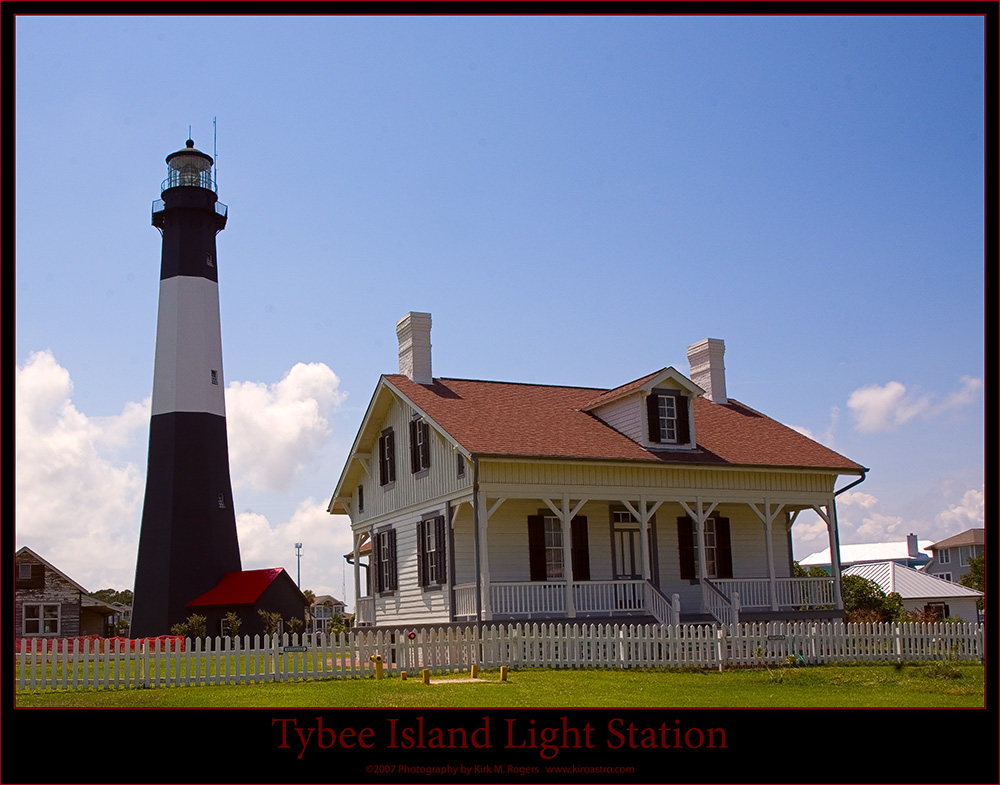
|
| The Brown Pelican images I took in the blue skies at the beach were as good as any I’ve taken of birds on the wing. Overall, I was pleased with this group and always enjoy the opportunity to practice. The 400mm f/5.6L is a great lens for this type of imaging being lightweight and easy to handle while panning. This lens on my 5d body makes a great combination – this was one of the few times I’d ever used this camera/lens together as generally the 30d is employed with this lens as a secondary system to the 5d/500mm f.4L set up. |
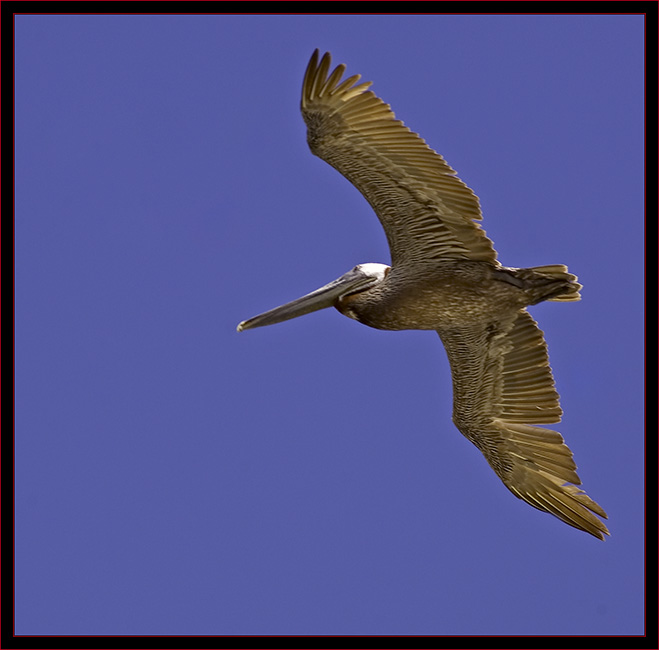
|
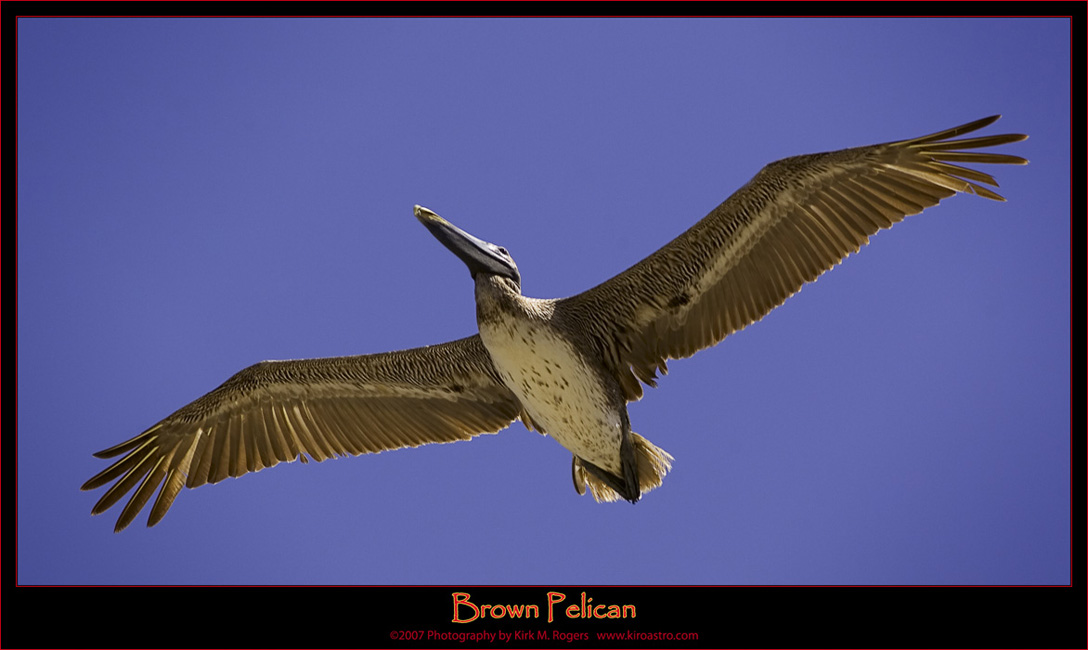
|
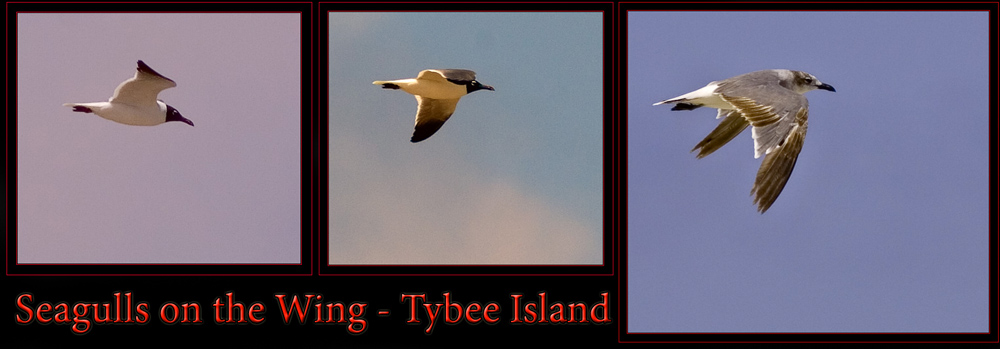
|

|
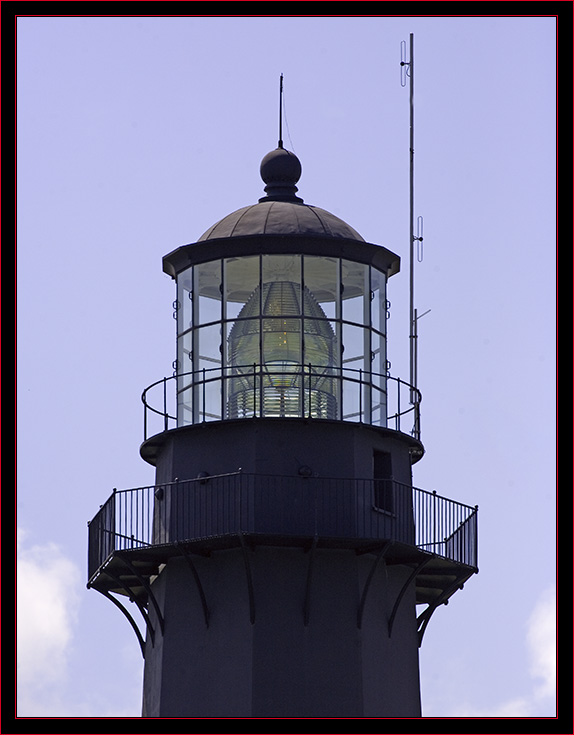
|
On the way out I took a few images of the First Order Fresnel (pronounced fray-nell) lens at top of the lighthouse (lenses are ranked in six sizes entitled orders – the weakest, ranked
sixth and used in inland waterways to the first-order - the brightest and deemed suitable for fog-bound coasts). This assembly is nine feet tall to provide some idea of the image scale. The light station has undergone a
recent renovation that was structured to maintain the historic integrity of the buildings and it shows... The information available indicates the light station is displaying the 1916
day mark (lighthouses have what is known as a day mark and night signature and no two are alike. The day mark is the color scheme/paint pattern designed to prevent misidentification
by mariners. The night signature is a light pattern specific to an individual lighthouse). Feel free to visit the Tybee Island Light
Station website for more really great information about this and other lighthouse related topics.
|
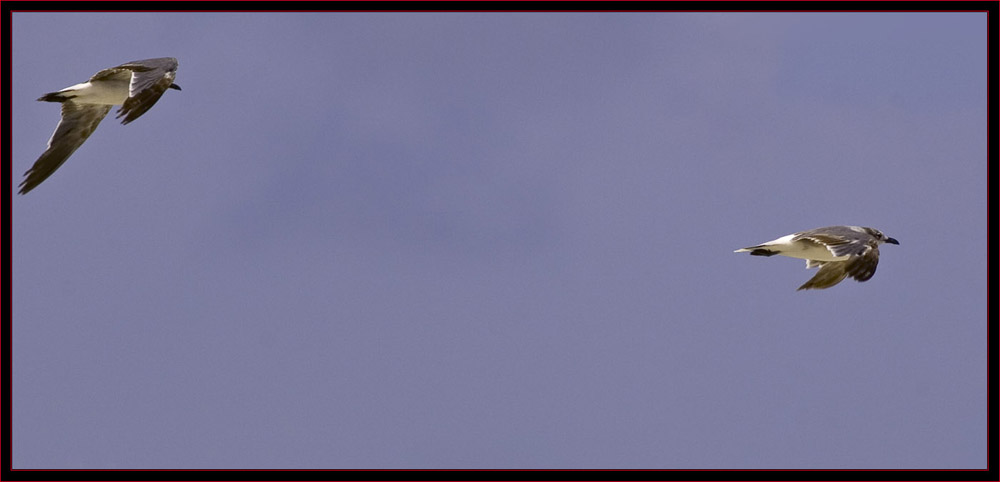
|
|
We didn’t see a great deal of activity at the refuge, at least not as much as the day before. There’s always something new to be found depending on how much effort you wish to
exert and talking with people around at the various stops is always interesting. We spoke with a family visiting from Atlanta and they looked like they planned to do some fishing.
The water was low and the banks were exposed; this brought the Fiddler Crabs were out and they were doing their thing along the mud banks.
This Great Egret was perched in a tree along the roadway. We viewed several fine examples of this common wader.
|
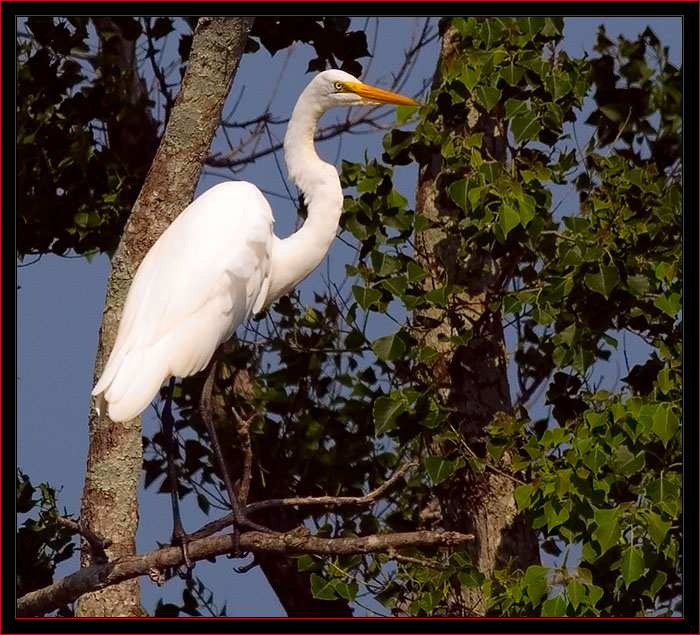
|
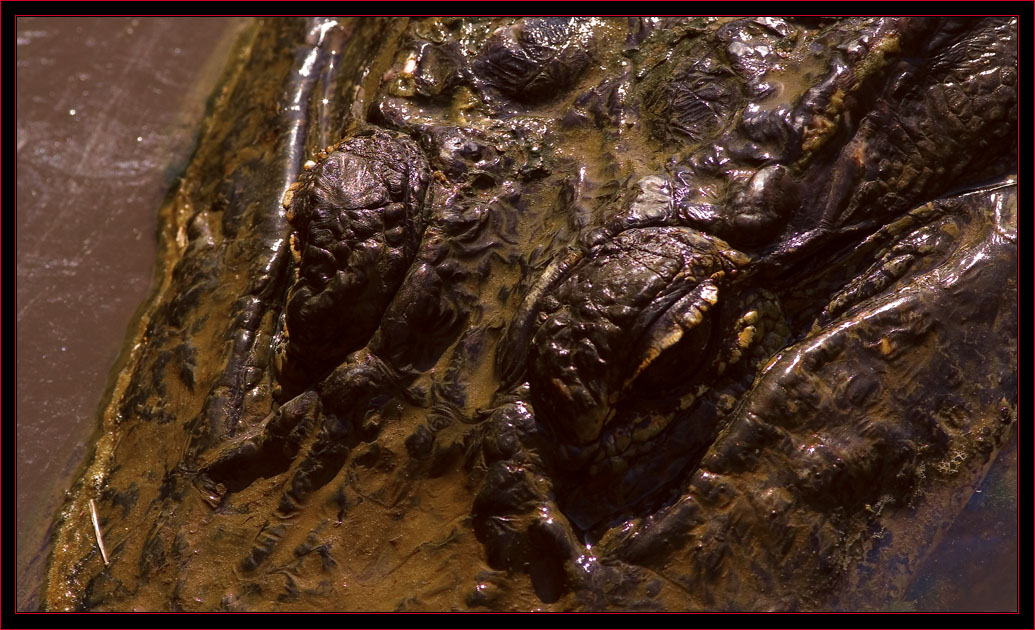
|

|

|
June 26th
We returned to the project site at 0900 hours for the remaining meetings. Things actually went quite well as two of the subcontractors were waiting when we arrived. By late morning we were all set and after speaking with Billy about any updated information he may have had pursuant to obtaining the permit, we headed downtown. Rich drove around with no parking nearby, while I visited the City Building Department to learn what I could. In the end result I didn’t walk out with the permit but indicated I would back the next day before noon to inquire again as directly afterwards we were heading to the airport and home…
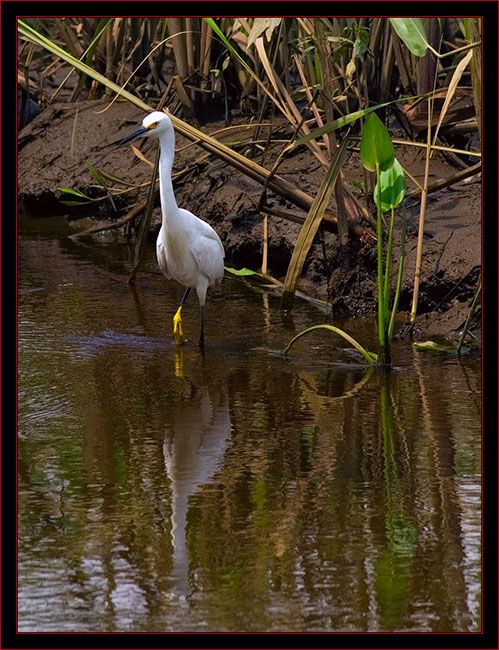
|
After the visit to the city offices there wasn’t much more to do other than making a few phone calls and check in with our offices. Rich asked what I’d like to do and,
you guessed it, I wanted to cross the bridge and check for anything new at the Savannah NWR. I suspected by now Rich was thinking this was getting a bit tiresome but being
a good sport, off we went. We’d made plans to meet Billy later for dinner to discuss provisions we’d made to commence the rehab so I thought it would be good to check
out some photographic opportunities while it was still early.
When we arrived at the refuge it was quite warm – really warm by our standards. The sun was blazing and the wind was blowing harder than either of the previous days. We weren’t exactly pressed for time but I had no intention of standing out by the road in the sun with no cover for any length of time. We found it interesting that the time of day one visits the refuge can more or less determine what creatures may be available to observe. A Snowy Egret foraging. Another common & beautiful wader, these birds use their bright yellow feet to attract fish. |
|
We stopped at the resident gator pond to see if the usual critter was hanging out… The alligator was there and for the first time that week the animal was entirely visible.
I don’t believe he/she was in stealth mode today but was more interested in soaking up some rays on this warm day.
The image at right was the only one I took all week that wasn’t with the 400mm f/5.6L lens. I wished to photograph the length of the animal so changed to the
24-105mm lens for this photograph.
|
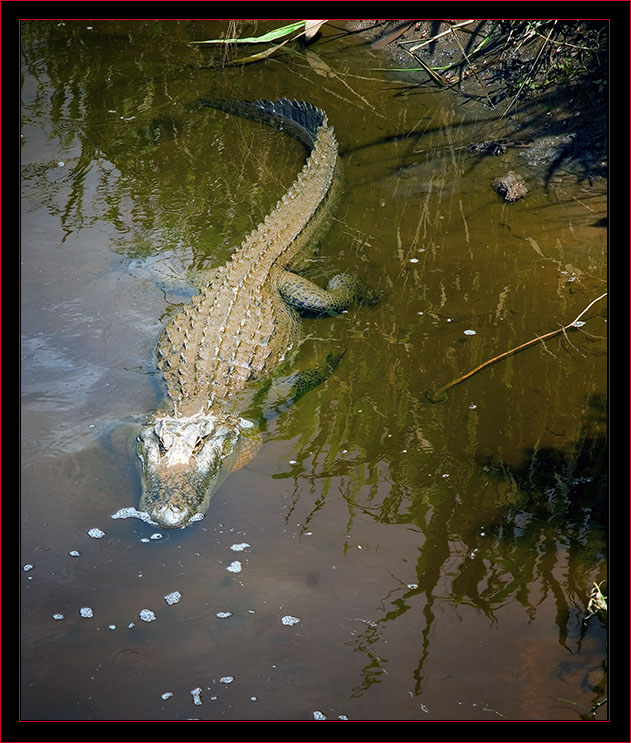
|
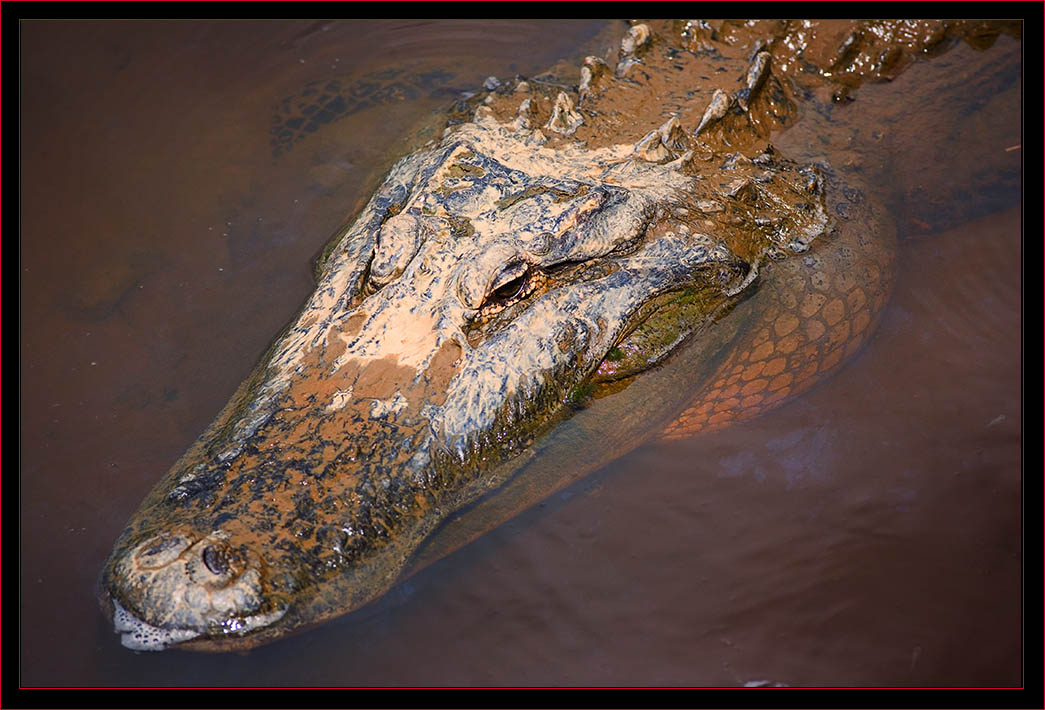
|
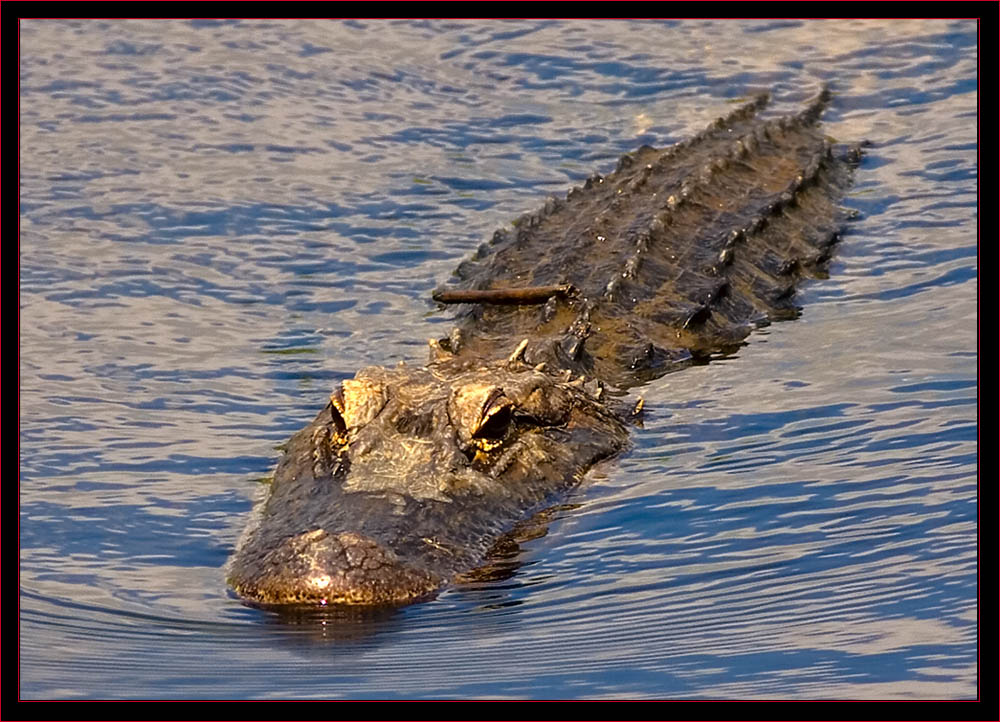
|
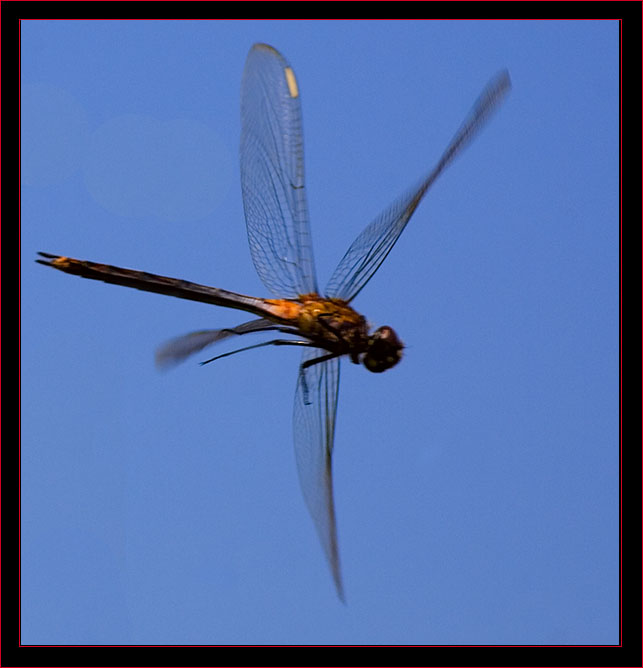
|
And yes, there were more dragonflies around and yes again, I chased around trying to get some good shots of them. This day was especially difficult as trying to check composition,
get a focus lock before the subject darted off and then gauging the wind to know when to take the exposure combined made things more arduous.
As challenging as this could be (and was) I also attempted to get a wing shot or two. As one can easily imagine this wasn’t a great success. However, the image at left is definitely a ‘dragonfly on the wing’ photograph. Remember the close focus on the 400mm lens is 11.5 feet so I wasn't exactly on top of them... |
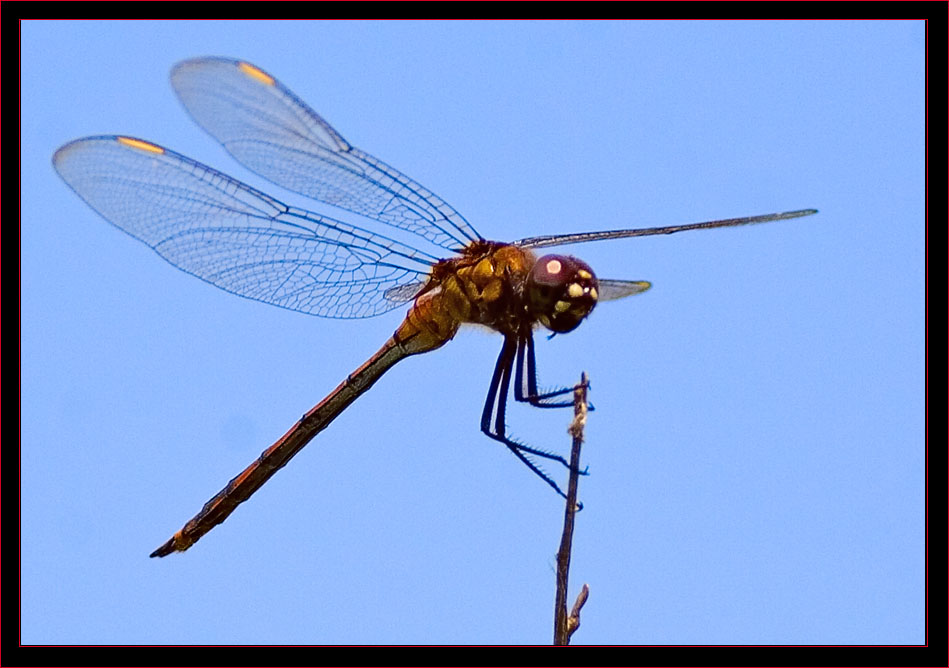
|
I’ve heard the term ‘water moccasin’ quite a bit and it appears to be somewhat generic. I believe this snake is a Cottonmouth and if so is best left alone as far as I’m concerned. This sighting was fleeting at best and the snake went back into the murky water and was lost from view.

|
| Before we left the ‘gator pond’ this egret flew in to see what was going on. This image was taken not far from where the resident gator was hanging out. It appeared that the neither the snake nor this egret warranted a glance when they were in the alligator’s area. |
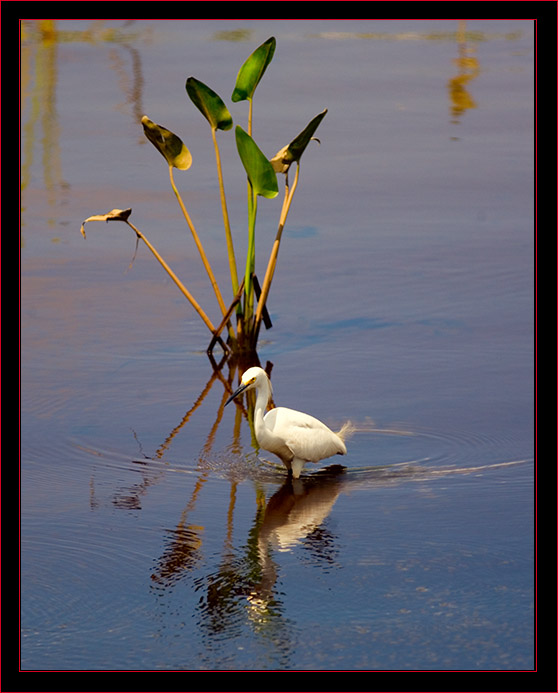
|
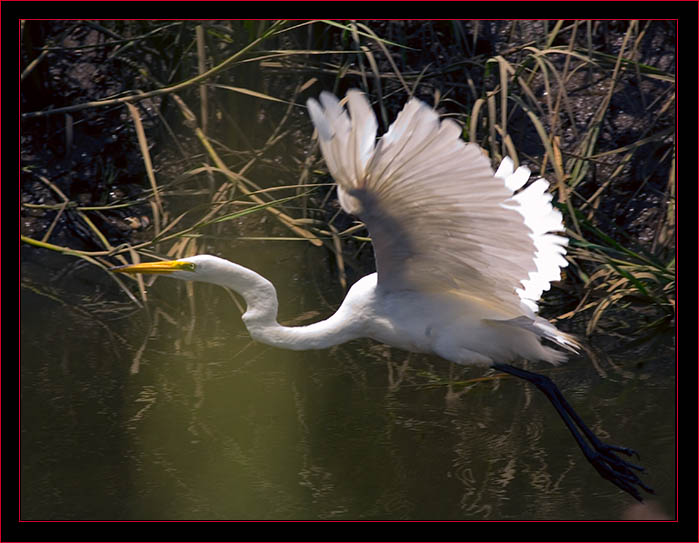
|
As we drove along the road further into the four-mile stretch I was pleased to see a great deal of bird activity. After we rounded a bend with no other vehicles present,
I spotted several egrets and a Great Blue Heron. I got out and was making an approach to get a few images when this beat up looking pick-up truck came by going way
too fast for the conditions, kicking up dust with the radio absolutely blaring… This wasn’t conducive to imaging foraging birds to say the least and I don’t
understand how anyone could be enjoying a ‘nature drive’ under such circumstances. To each his own I suppose but stressing animals when we’re the intruders
in their environment isn’t fun for them I’m certain. There are park regulations posted at facilities and on the web about this type of thing but mostly it’s
predicated upon common sense. We weren’t the only people driving along the road observing as the truck flushed everything around.
Because I’d been approaching a Great Egret, I was in a position to shoot several exposures as the bird headed off to parts unknown, including the one at left. |
|
We viewed some cattle egrets ahead in the road and as usual as we moved closer they moved down keeping the same distance between us. I was hoping to get close enough to get a
good head shot for detail on one of these but it became apparent this wouldn’t happen, at least not right at the time.
However, a few decided to fly off and when they did I was able to get some flight images. It was a hot, sunny day and one advantage of this type of lighting is fast shutter speeds when you point your lens skywards. I was pleased with this image and the full size version will make an excellent print… |
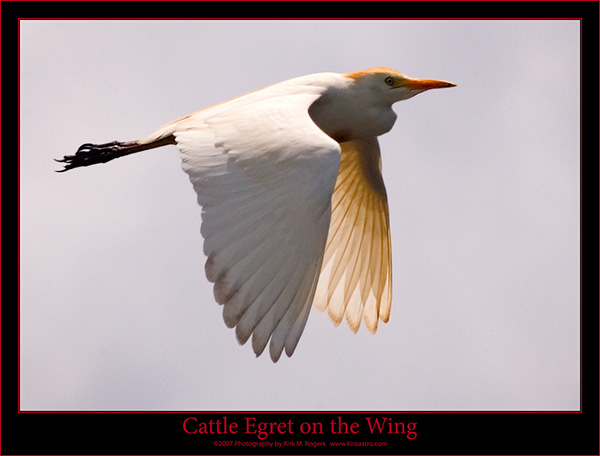
|
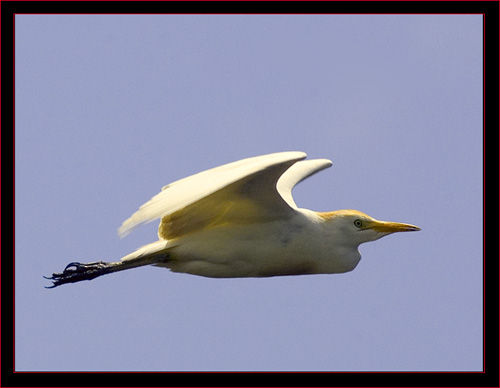
|
This is the same egret imaged on the up stroke. You can tell it’s the same bird and I found the lighting changes interesting between the two photographs. Both exposures were taken within seconds of each other with no changes to the camera settings. |
|
I knew about a small pond area that was kind of isolated from the others about three-quarters of the way into the drive. Several years ago I was at this spot when a baby
alligator popped up not far from where I was standing. I’d check this pond both days previously and didn’t see much of anything around. This pond appears full of vegetation
and fairly static compared to some of the others. I figured it would be loaded with frogs, turtles and the like and I’m sure it is, we just hadn’t viewed any. Well
today was different… First of all Rich spotted a red dragonfly, the first we’d seen in the last few days. After this sighting and trying to locate others of those he
spotted, we were on a bit of a quest to photograph these and we were ultimately successful.
I told Rich about the baby alligator and as we looked into the water he spotted a pair of eyes not far from where we were standing. After a time we realized this wasn’t a baby anything but we were impressed with the camouflage – the gator was perfectly still and blended in so well as to be invisible without careful scrutiny. At right is a head shot of this gator. |
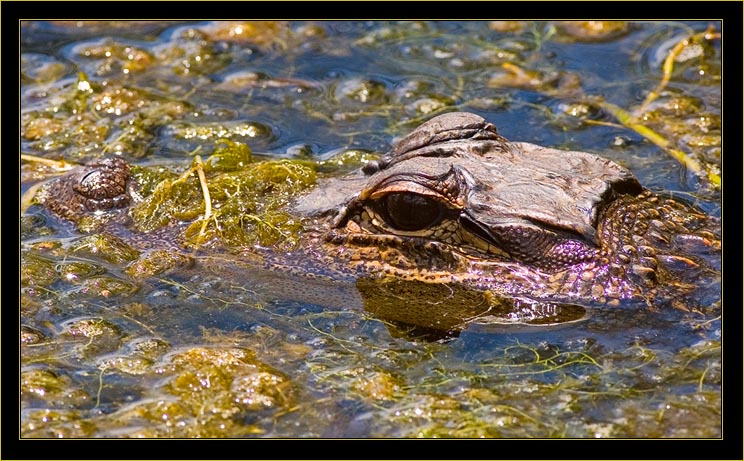
|
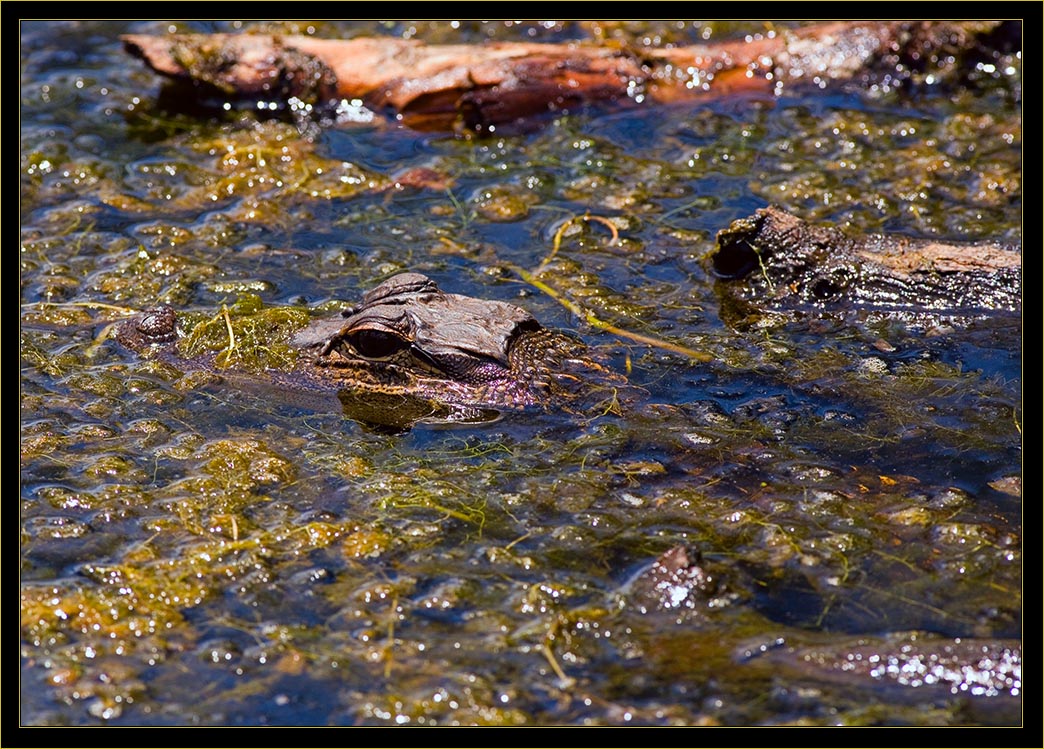
|
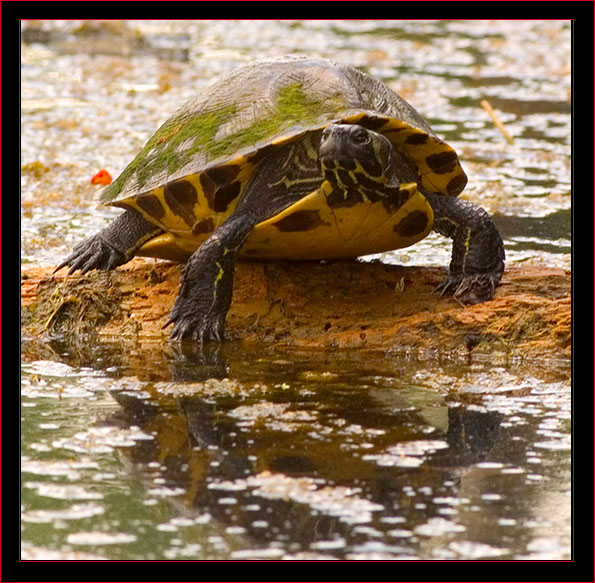
|
On this day the turtles were hanging out on the logs catching some rays… These turtle shots were all from the same pond as the gators above. We viewed about ten altogether – some swimming around, others out of the water sunning. |
| View from behind as this turtle crawled down the log. Some of his compatriots had already made it to the end and scurried into the water. These images provide a good ideal of the vegetation choking this pond. |
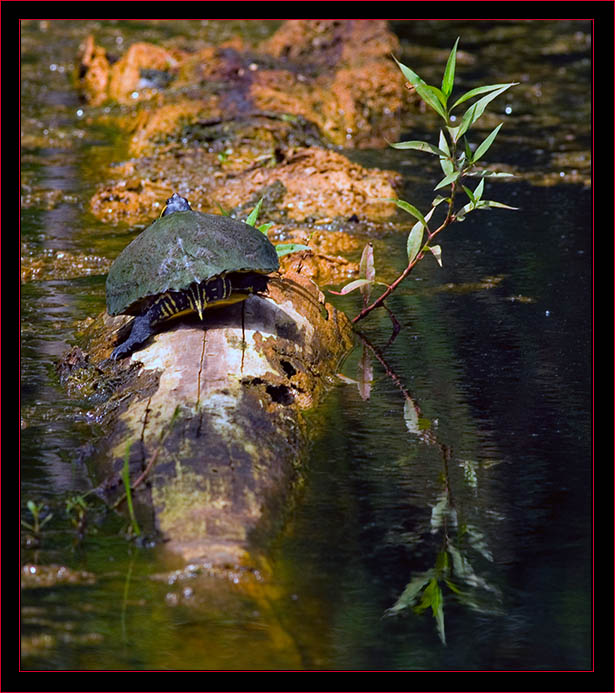
|
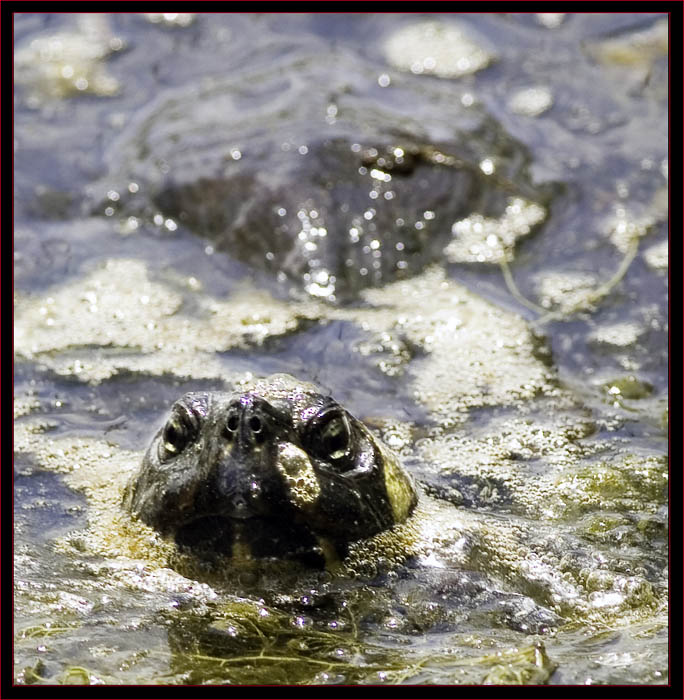
|
I like this photograph – it makes this turtle appear to have a really elongated neck where the shell is so far behind the head. He/she was checking us out when this image was taken. |
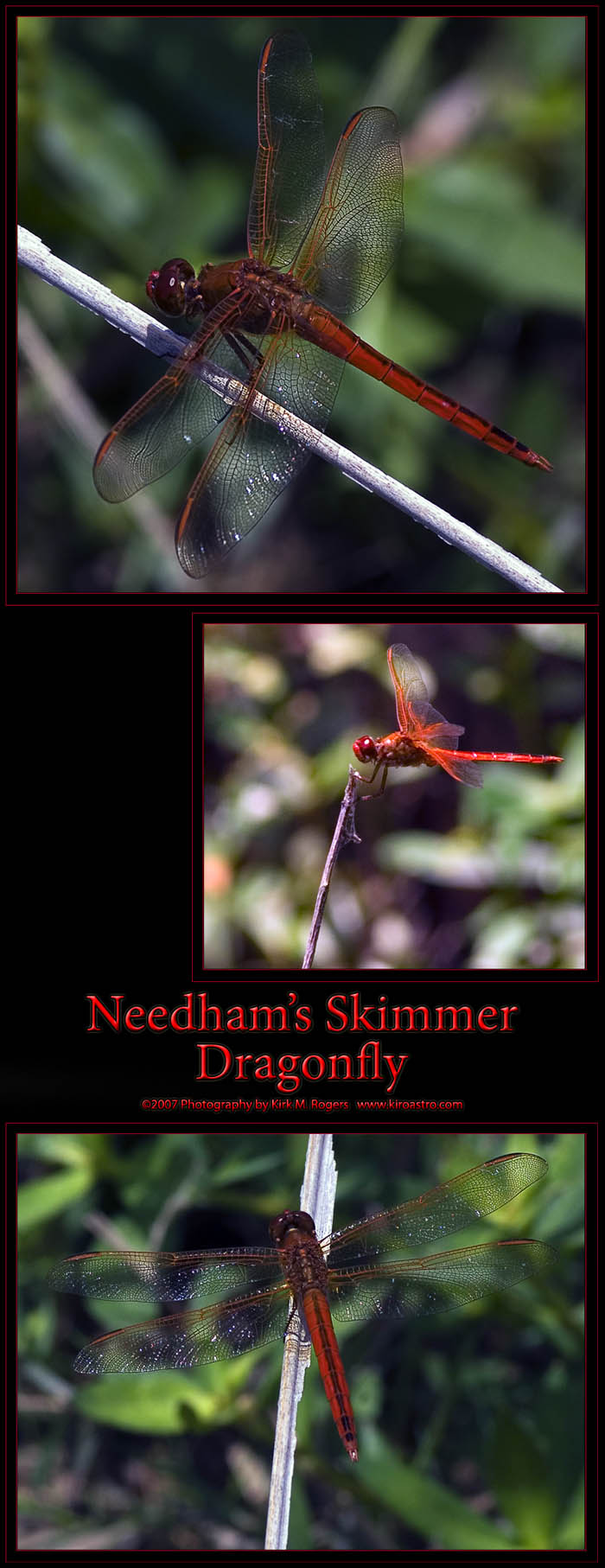
|

|
| Several times over the various visits at the refuge I’d spotted birds flying like kamikazes across the water – they flew like they were escaping Hades and really moved along … They looked vaguely familiar and the yellow legs were striking in flight – I just didn’t get a good enough look to know what it was and they were generally far away. I didn’t carry any binoculars this trip which may have proved helpful. As I was walking along the tall grass lining up dragonfly shots one of the birds took off and I spotted it out of the corner of my eye. I had time to get the camera up and took two rapid exposures. Although neither was great it was enough to identify the bird at right – a Green Heron… I have some excellent photographs of this bird but never recalled seeing one fly. We never once spotted these secretive birds in the refuge except for those on the wing. |
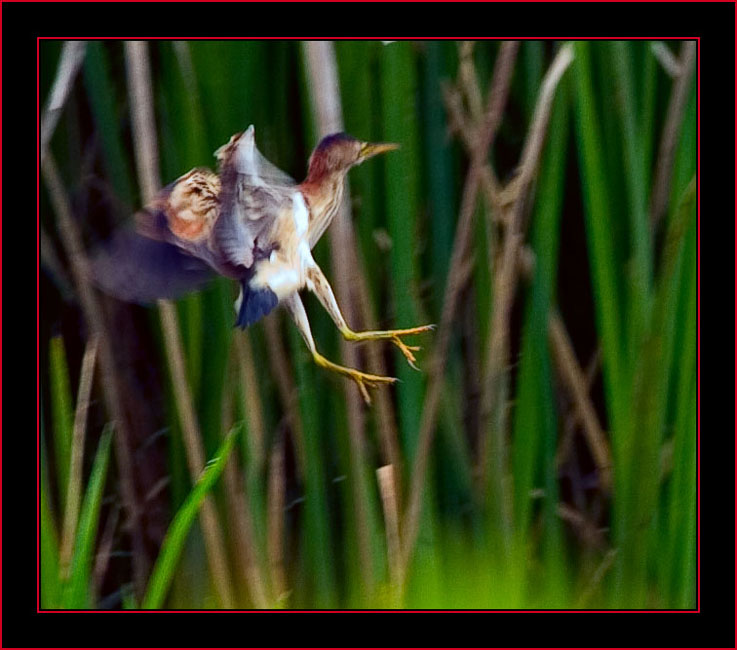
|
We were ready to get back to the hotel, meet Billy to go over some work requirements and make preparations for the flight home the next day. Although we’d only been gone since Monday, the thought of getting home was okay with both of us.
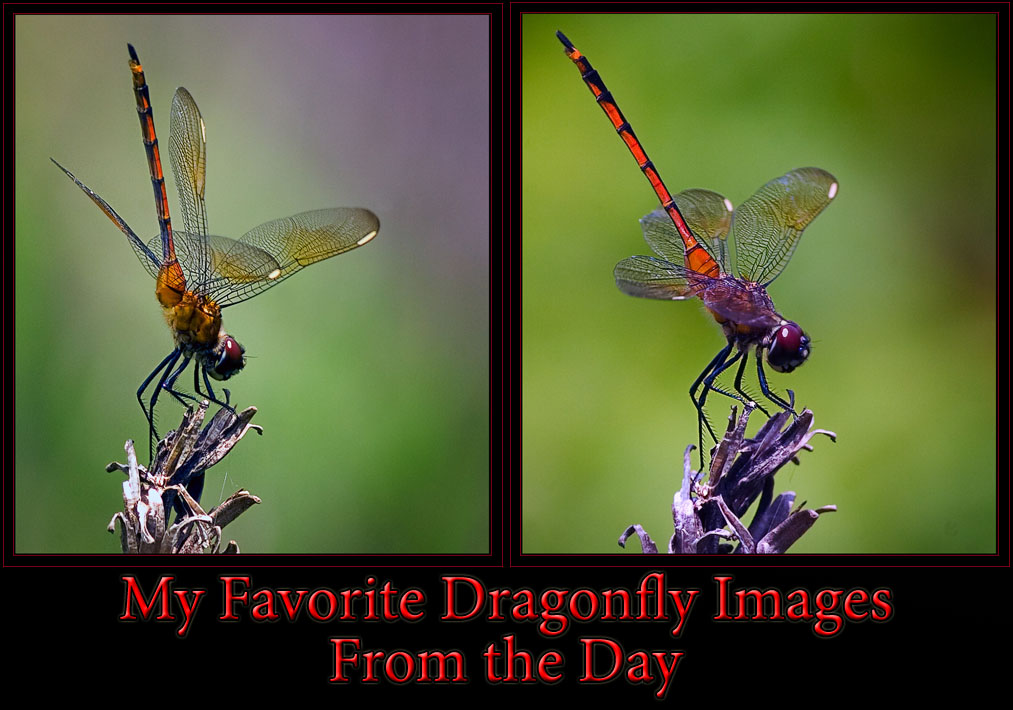
|
June 17th – Our Final Day in Georgia – Almost…
Our flight didn’t leave the Savannah/Hilton head Airport until late afternoon so we had time to type some notes and kick back a bit in the morning hours. Much to my chagrin, I wasn’t able to get on the hotel’s wireless system, which is a significant issue for me, so I used one of the lobby computers to read emails and stay in touch. Earlier this morning I’d gone down to print my boarding passes for the flight home and had some breakfast. I was ready to go…
The only work task we had to follow up on was obtaining the permit. Visiting the Building Department would be the last thing we did before leaving the downtown area. As things turned out, I didn’t leave with the permit. It was again delayed and they indicated I should come back ‘later in the day’, which clearly wasn’t going to happen. The good news – we now have the permit as Billy picked it up the next day – I left him a check for this purpose and this was a large step forward for the commencement of the work.
We allowed more than ample time to get to the airport to return the rental car and check our bags. It didn’t take us long when we got to the check in counter to recognize things were not good. Linda had called and indicated the Portland Jetport was posting flight cancellations, including our inboard flight, all afternoon. We learned this was supposedly due to thunderstorm activity. Soon enough we learned one couldn’t obtain a seat to the northeast for love or money… The airline fellow we were dealing with was seeking seats into Sunday and Monday before we left. He eventually booked us on a flight that arrived in New Hampshire at 2200 hours Saturday evening (keep in mind it was then Thursday afternoon). We could rent a car and drive in from there.
So we rented another vehicle and searched for a hotel with availability near the airport. Because the cancellations were ‘weather delayed’ we were entirely on our own with no vouchers of any kind… Once checked into the hotel I called my office and asked them to contact our business travel agent for alternate flights home. I won’t continue with an account of this 'adventure' but will state we finally got a flight into Boston where we again rented a vehicle and drove to Maine arriving Friday evening. Come to find out we were lucky, other people I've talked with had far worse delays and longer drives before that got back in state…
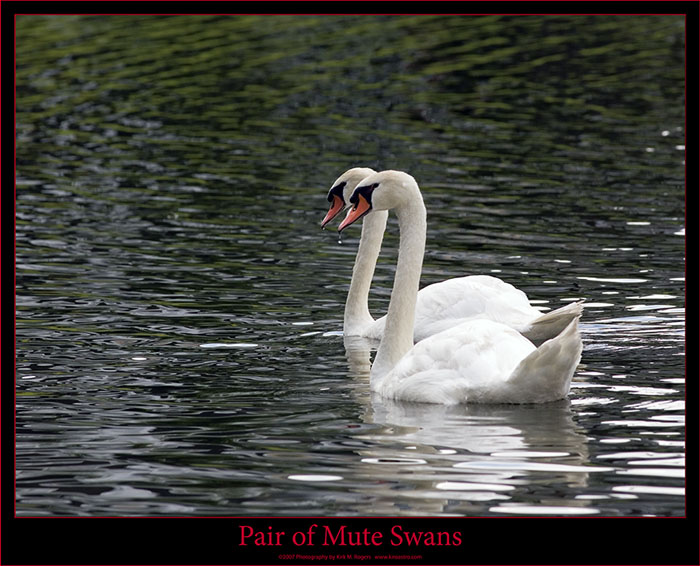
|
So once again we had time on our hands although we'd spent multiple hours in the airport seeking alternate flights and by now it was early evening…
Rich probably figured I’d want to return to the refuge but this wasn’t the case. As I walked into the hotel lobby with my camera one of the desk staff told me he knew about some red fox sightings nearby and a gator or two. We decided to go for a short drive to look around but other than some Killdeer near the hotel didn’t see much. Rich had rented an apartment near this area and was somewhat familiar with the environs. He’d mentioned he knew where a pair of swans lived and asked if I’d like to go check this out, which I certainly did. I was surprised at how close this was to the hotel. So the final entry for this article will be a few of the swan shots near the airport in Savannah… |
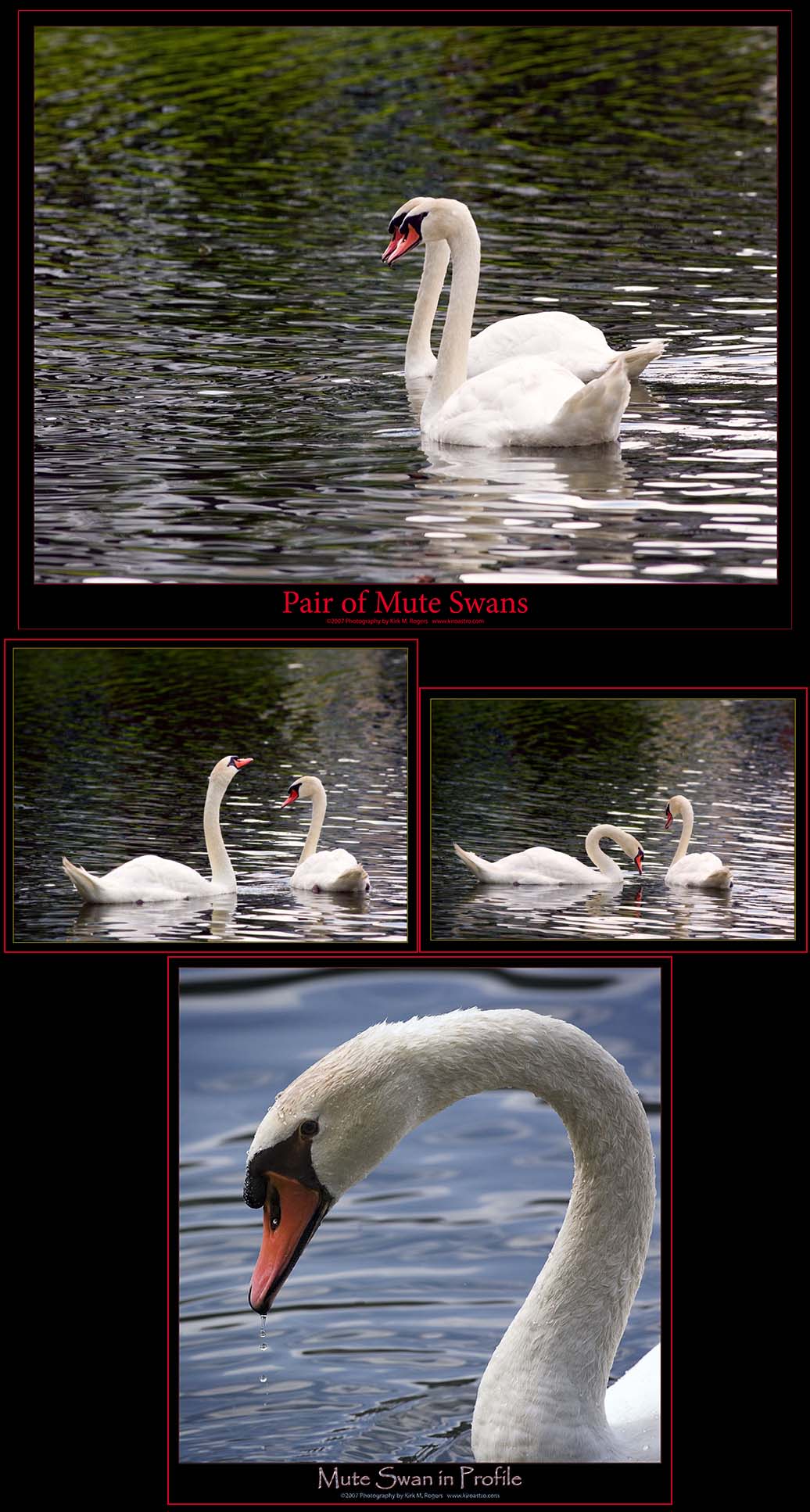
|
Kiro
July 2007